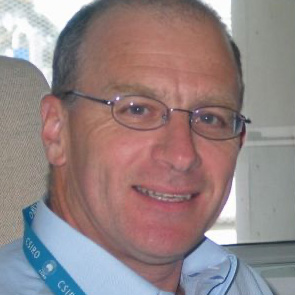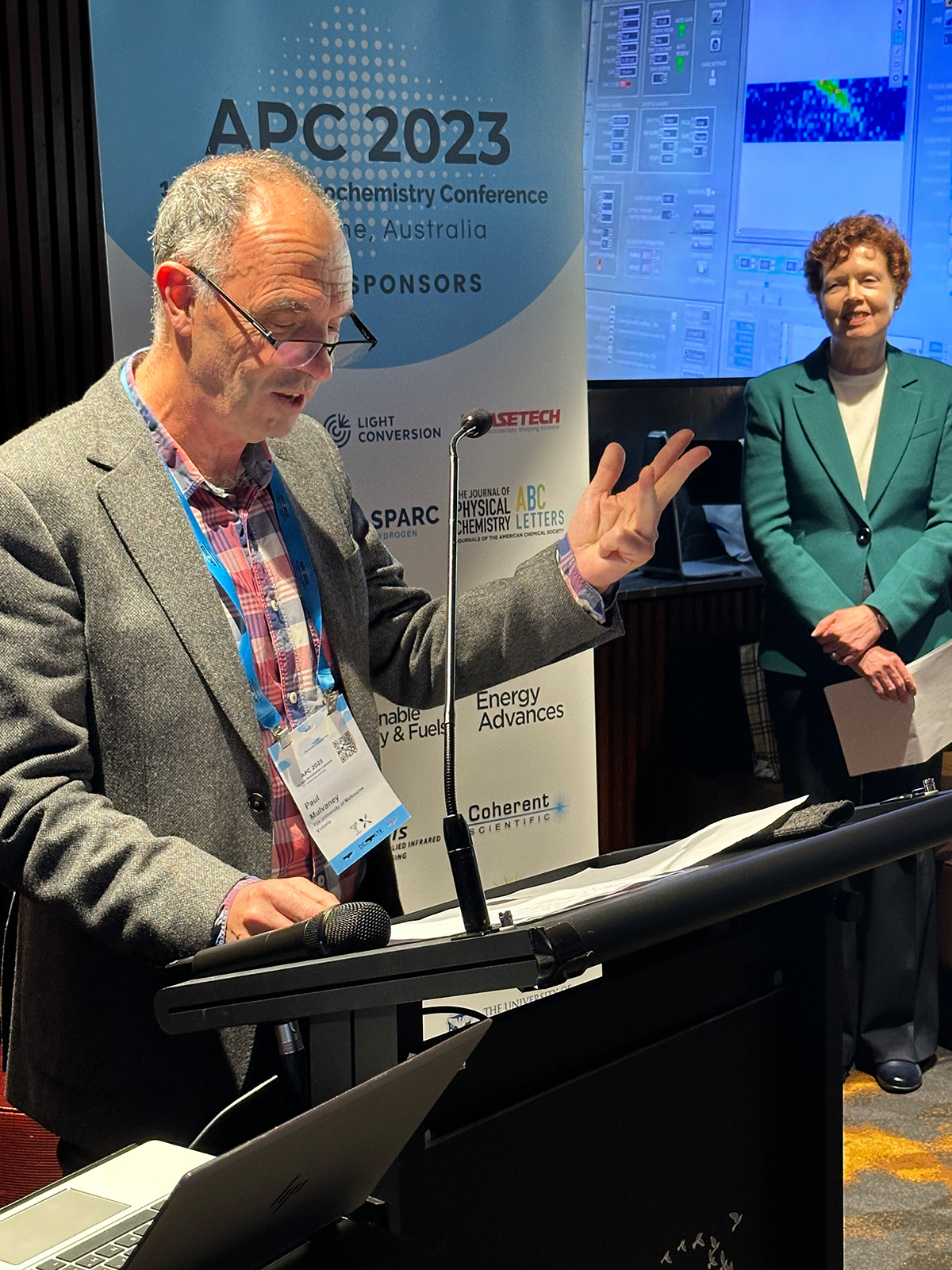Leadership Reports
In this section
Chair's Report
I recall a meeting held about eight years ago on a Saturday morning, upstairs in the 1888 Building on Grattan Street at the University of Melbourne. Exciton Science’s successful application for an ARC Centre of Excellence had just been announced and those who were at that meeting will recall a great deal of excitement and energy in the room - along with a real sense of urgency. The expectation was that we were on the cusp of something BIG. Looking back, it seems like that meeting was several lifetimes ago!
As a Partner Investigator at CSIRO, I was keen to observe how the core group of investigators would transition through the various stages of team performance (i.e. forming, storming, norming and performing). The proof of the pudding, as they say, is in the eating. In this case, the outputs and impact from the Centre across all its platforms (science, outreach, communications, diversity and inclusion) has demonstrated just what an outstandingly successful Centre it has been and what a great team we have had to take us along that journey.
Everyone will have their own personal highlights. For me, this falls into two categories: achievements and legacy. The fact that the Centre consistently exceeded (indeed smashed) our key performance indicators is a very satisfying accomplishment. Furthermore, the development of a strong cohort of early, mid and late-career researchers that are technically brilliant, collegiate, IP savvy, and with high personal integrity is an enduring legacy that will live well beyond the life of the Centre.
On a scientific note, of particular interest to me is how the Centre is combining computational and high-throughput materials discovery along with device optimisation to accelerate the speed-to-market of products in the energy transition sector. It’s an important capability in an increasingly competitive global race.
For any organisation, the culture is set from the top. And our Director Paul Mulvaney, as modest as he is, deserves huge credit for the way in which the Centre has operated from Day One. Together with his broader team, he has created a safe, inclusive, nurturing and intellectually stimulating environment for all.
So, as we enter the final year for the Centre, we come to the end of the ‘performing’ stage and move on to the ‘mourning’ stage. This equates to giving ourselves a well-deserved pat on the back and recognising all the members of the Exciton family, past and present, that have contributed to its success. Finally, I hope you enjoy reading about our many latest achievements in the 2023 Annual Report.
My best wishes for future success to you all.
Gerry

Dr Gerry Wilson
Chair
Centre Advisory Board

Professor Paul Mulvaney
Centre Director
Director’s Report
Dear Excitonians,
Well, we got here. And we got here together! 2023 has been a fantastic year, as well as being the last full year of Australian Research Council funding for our Centre. It feels like just yesterday when we were putting together a team of researchers to help transition Australia to a sustainable energy future, way back in 2016. We thought that successfully acquiring seven years of funding would be like climbing Everest. Bit by bit, stage by stage, we got there, and I think we have climbed some even bigger mountains since then.
It has been a fun-filled and action-packed journey and I am immensely proud of all of the people who have been part of the Centre – staff, students, postdocs, partners, collaborators, advisors, friends and family members. It has been fascinating to see the teamwork and synergy grow over time within the Centre, to watch people’s ideas evolve, to witness skills increase, and notice how student confidence is boosted during time in our labs – it has all been an amazing trip for this Director.
We set out to study the interaction of light and molecules, to better understand how we can harness sunlight and use its energy for useful human activities. In 2023 we ended up with a mammoth 240 people being associated with our Centre, the highest number to date.
The pinnacle of 2023 (for me at least) was having the Centre host the 12th Asian Photochemistry Conference. Being able to see our emerging stars giving lectures to a world-class audience was a proud moment for me.
It has been another very successful 12 months, with 107 scientific publications across our five nodes. We have managed to get some more intellectual property out of the research and a second spinout company has been formed. Congratulations to GreenShield Solutions!
Our communications team has done a brilliant job publicising the work of the Centre, but not every paper gets its own headline. Relatively unsung research makes up the bulk of our papers in 2023 and a huge proportion (42%) of our work this year appeared in high-impact (IF>10) journals! Only 2% of papers published worldwide are in these premier journals. This high impact fraction has grown dramatically in recent years and demonstrates how the Centre has really built its impact and momentum.
Following Covid-19, everyone has worked hard to rebuild links to industry partners and overseas collaborators, which is reflected in the large climb in visitor numbers. It is also great to see PhD and MSc graduations growing again after the chaos of the pandemic. Another unsung statistic is that, by our reckoning, more than 40% of people leaving the Centre have found employment in the green economy.
Before you read on, let me also put in a particular note of gratitude to Kate McGeoch, who was our Chief Operating Officer for five years and really helped us to hit our stride as a Centre. Her leadership and governance was invaluable. In November 2023, Kate moved on to a senior role in the Research Office at UNSW.
I was delighted when Dr Nicholas Kirkwood, formerly the Centre’s Science and Industry Liaison Manager, agreed to step up to fill her shoes as COO. Meanwhile, Chief Investigator and Executive Committee member Assoc Prof Wallace Wong has agreed to serve as Acting Director in 2024.
The Centre has been very fortunate to have had input from three Boards, who have provided stimulus, direction and the occasional kick up the backside. I would like to thank all of the members of our International Scientific Advisory Committee (Elsa Reichmanis, Marc Baldo, Jenny Nelson, Jochen Feldman, Neil Greenham, K. George Thomas and Hiroshi Masuhara), our current Centre Advisory Board (Gerry Wilson, Moira O’Bryan, Elsa Reichmanis and Amanda Caples) and our Industry Advisory Board (Scott Watkins, Victor Rosenberg, Michael Brear, Nicola Morris and Harold Yap). The generosity with which all board members past and present gave both time and thought to help the Centre has been greatly appreciated by everyone.
The greatest challenge for basic science in Australia remains the connection to industry, especially manufacturing. I’d like to thank our industry partners (Reserve Bank of Australia, CSIRO, DSTG, Agilent, Dulux Group, ClearVue PV, Woodside Energy, BluGlass, and Young Henry’s Brewery) for your sustained support of our research programs.
We have had really positive feedback about the experience of working in a CoE from 98.2% of our students, according to university surveys. For the opportunity to have our own Centre we also thank and acknowledge the support and ongoing guidance of the staff at the ARC, particularly Liz Visher.
Anyway, as you can see at the back of this report, we have hit the majority of our KPIs for 2023 comfortably! Thank you to everyone for your contribution. Happy reading!
Professor Paul Mulvaney
Director, ARC Centre of Excellence in Exciton Science
Science Committee Report
One of the nicest parts of helping to manage a multi-million-dollar research project is that towards the end, there is a steady stream of exciting new results from the many talented researchers in the Centre.
2023 was certainly a big year. As the hardworking administration team have been focusing on our entry to the ‘wind down’ phase of the Centre, impressive research from Centre members just keeps coming. I thought I would use my report from the Science Committee to highlight some of the amazing work produced across all platforms of the Centre in the last 12 months.
In the Annual Report, you can read about the work that has taken place at UNSW Sydney using organic light-emitting diodes (OLEDs) to image magnetic fields. Although we are all now familiar with the presence of OLEDs in the latest televisions and smartphones, Centre researchers have been able to show that they also have potential as small, flexible and mass-producible magnetic field sensors.
Over at Monash University, they have been using perovskite thin films to develop new types of X-ray detectors. Everyone knows the classic black and white image of a broken bone from childhood, but using perovskite films allows new types of detection which may have better energy and spatial resolution, all using printed thin-film manufacturing approaches.
At the University of Sydney, members have been designing solar cells for space applications that repair themselves. One of the problems for technology in space is it's a rather inhospitable environment! Yet as it turns out, with some clever design tricks, the sun’s light can undo radiation damaged suffered in the depths of space.
Researchers at RMIT University and their collaborators in Switzerland have demonstrated how machine learning techniques can be used to tune fluorescent polymers for colour displays, security inks and data storage. This machine learning-assisted polymer synthesis process is simple and easy to replicate, uses widely available materials, and can reduce optimisation times from years to weeks.
An excellent example of the benefits of cross-node collaboration is the recent publication of a roadmap for computing using excitonic logic. This paper involved researchers from UNSW, the University of Melbourne and RMIT, and is yet more proof of the value of joint appointments between groups in driving effective collaboration. In this roadmap, Centre researchers plot a pathway to using excitonic materials to realise entirely new types of computing.
Although the official ARC-funded component of the Centre is coming to an end soon, there are many new projects and initiatives starting up across the Exciton Science nodes. Almost every week I hear news of a talented postdoc or PhD student who is heading on to a new challenge, either elsewhere in Australia and internationally. In every case they are taking outstanding knowledge of excitons and related processes, skill in collaboration and advanced, emerging science to the world.

Professor Jared Cole
Chair
Science Committee
Home
Strategic Plan